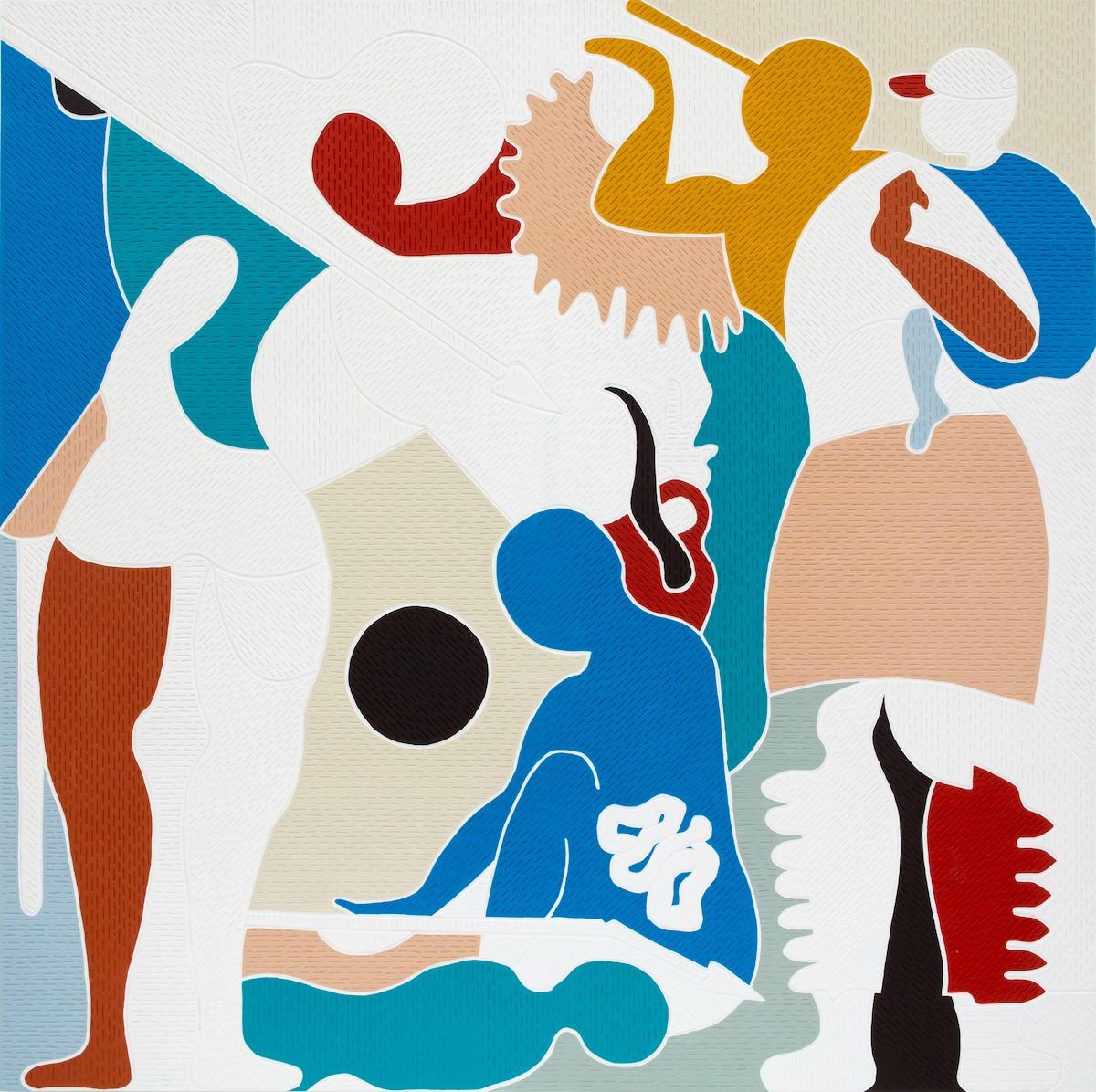
Naufus Ramírez-Figueroa, Study of the Cacaxtla Murals #3, 2024 Acrylic on carved wooden panel, 180.5 x 180 cm / 71 x 70 7/8 in.
On February 7, Zona Maco returned to the Centro Citibanamex, Mexico City’s massive convention center, to celebrate its 20th edition. The fair, which runs through February 11, 2024 features 140 exhibitors in the art section—ranging from international mega-galleries like Pace, Galeria Continua, GRIMM and Galerie Nordenhake to Mexico City’s popular kurimanzutto, Maia Contemporary, OMR and PROYECTOS MONCLOVA in the Main section. The Emerging sector showcases galleries including 193 Gallery, N.A.S.A.L., and Red Arrow, while there are many more exhibitors in sections devoted to photography, design, books, and antiques.
“I’m very happy with the fair this year,” Zelika Garcia, the founder of Zona Maco, shared with Art & Object when we caught her with collectors in the VIP lounge. “It’s great to see so many people back at the fair after a few years. The thing that excites me most this year is the Forma section, which places sculptures and installations throughout the fair. We have never had anything like it, except in the first year, when we launched, and needed to fill the space. This time, we commissioned artists to create site-specific works, with most of them being sculptural interventions and others as performance art.”
Art & Object has selected 10 works by artists, who we think are worth following and collecting, from the various sectors. Please scroll through to see our choices of the best artworks at this year’s fair.
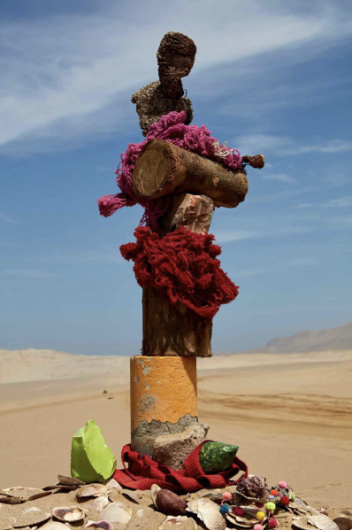
An Italian-Peruvian photographer and sculptor based in London and Murano, Lorenzo Vitturi puts his past experience as a cinema set painter to good use to create site-specific sculptural installations which he then photographs in situ, keeping only the photographic image as the final work of art. At the fair, the gallery is presenting a solo show of color photos and glass sculptures that revisit his father’s journey from Italy to Peru to open a glass factory, while meeting the artist’s soon-to-be mother along the way. Traveling with a nomadic studio stocked with pieces of Murano glass, pigmented ceramics and Andean fabrics and wool, Vitturi crossed the coastal desert and Andes creating interventions with his symbolic materials and salvaged things at hand—resulting in a series of spirited assemblages, which he documented and then left behind as mementos of his family’s journey to a new life.
Image: Lorenzo Vitturi, Green Cotisso, Eucaliptus Wood, Coca leaves & Abanicos in Paracas, 2021. Archival pigment print, 130 x 86 cm. Photo: Rag Baryta.. Courtesy 193 Gallery, Paris and Venice
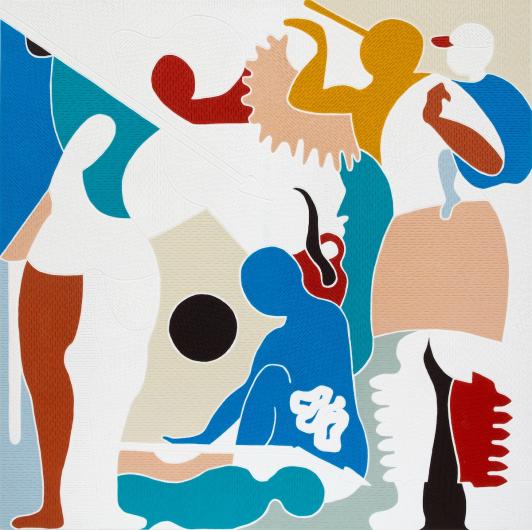
The subject of a solo show of related works at the gallery’s Mexico City location, where he is exhibiting paintings and sculptures inspired by pre-Columbian murals from an archeological site, Guatemalan artist Naufus Ramírez-Figueroa has this 2024 painting, Study of the Cacaxtla Murals #3, at the fair. Starting with a wood panel, he sketches his images and then carves out the outlines of the figures and chisels out cross-hatch patterns in different directions. Taking the murals, which mix Maya and Central Mexican cultures, as his point of departure, he changed the figures to reflect a more contemporary world. Depicting migration, such as the journey he and his family undertook to escape a civil war to start over in Canada, Ramírez-Figueroa presents his image of the new means of cross-pollination while putting his own childhood traumas to rest.
Image: Naufus Ramírez-Figueroa, Study of the Cacaxtla Murals #3, 2024 Acrylic on carved wooden panel, 180.5 x 180 cm / 71 x 70 7/8 in. Courtesy Galerie Nordenhake, Stockholm, Berlin and Mexico City
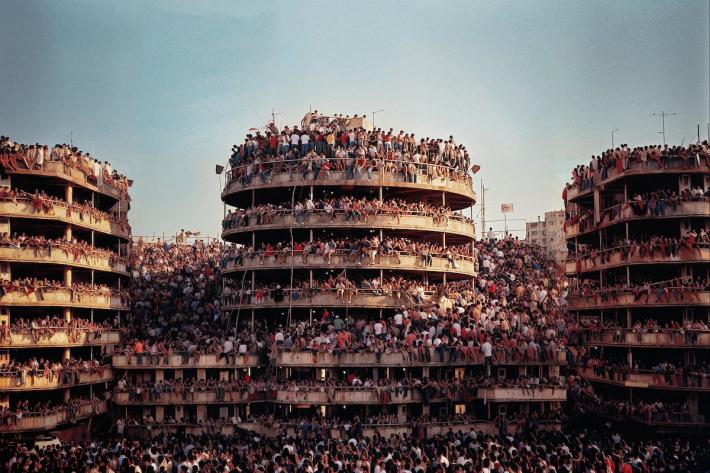
Part of a group exhibition of eight international artificial intelligence (AI) artists curated by Alejandro Cartagena in the gallery’s booth, Turkish artist Alkan Avcioğlu, has four medium-scale color photographs that show the results of uncontrolled immigration in his startling series, “Overpopulated Symphonies.” Portraying people occupying shelves of overcrowded rooms, packing balconies and streets, and overflowing from parking garages, images like Symphony No. 1 in D Major, Op. 3, Presto: "Convergence" not only expose future possibilities of overpopulation of urban environments, where everyone comes for a job, but also the over-abundance of information that city-dwellers are already processing—with each new visual or idea vying for space in our minds.
Image: Alkan Avcioğlu, Symphony No. 1 in D Major, Op. 3, Presto: "Convergence", 2023. Archival pigment print on cotton paper, 26 3/5 × 40 in / 67.6 × 101.6 cm. Courtesy Patricia Conde Galería, Mexico City

A Mexican conceptual artist working with photography and sculpture, Mauricio Alejo is best known for his ironic images and installations involving everyday objects and situations. Taking as his starting point a famous multi-flash photograph by Dr. Harold E. Edgerton of legendary golfer Bobby Jones’ swing with a driver, Alejo has constructed a semi-abstract, sculptural version of the image using readymade, store-bought products. Removing the figure while capturing the movement of the clubs (using a variety of sizes of sleek drivers), he’s clamped them on a cluster of stainless-steel stands to create a whimsical machine-like object that makes photographic connoisseurs stop in their tracks. Part of a selection of sculptural works spread throughout the fair in the Forma section, The Unfathomable Illusion that Eternity Exits II is vying for a USD 100,000 prize to be awarded by the Erarta Foundation to the winner, chosen by the fair’s attendee.
Image: Mauricio Alejo, The Unfathomable Illusion that Eternity Exits II, 2024. Stainless steel metal clamps and golf clubs, 305 x 254 x 208 cm. Courtesy Curro, Mexico City
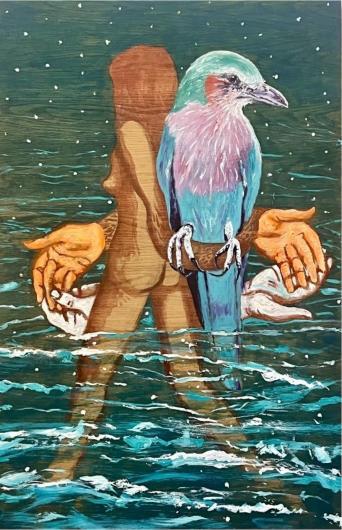
A painter and sculptor of bicultural American and Mexican heritage, Ray Smith visually explores the human condition by fusing the popular styles of Mexican muralists with the abstraction of the European modernists. Referencing the nature surrounding Cuernavaca, Mexico, which is the place where he grew up, his 2023 painting Enjuague (Rinse) captures a seductive nude woman knee-deep in a pond with her extended arm surreally becoming a branch for a perching bird, that’s equal to her size. Carrying the surreal quality of the painting even further, while adding a somewhat spiritual twist, two sets of hands embrace the figures as they clasp one another. Painted on plywood, the wood grain adds a final touch to the dreamlike narrative, which may be based on myth or the basis for a parable that Smith’s painting may inspire.
Ray Smith, Enjuague, 2023, Oil on wood, 122 x 80 cm. Courtesy Estéreo, Monterrey
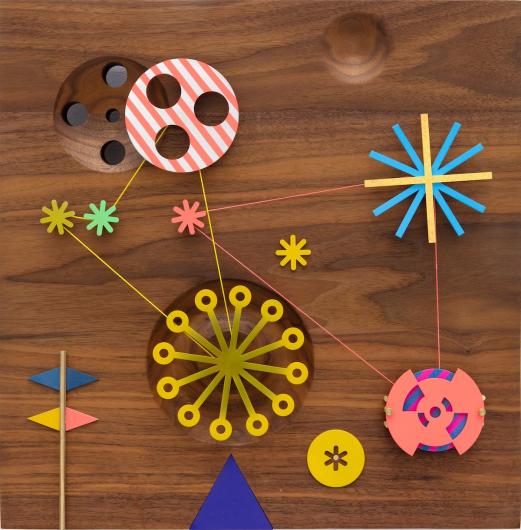
Fascinated by contemporary design while questioning its symbolic and economic value, Mexican sculptor Edgar Orlaineta puts the elements of graphic and industrial design to new use in his playful yet sophisticated works of art. For his colorful kinetic piece, Dynamo, the artist was inspired by Charles Eames’ Solar Do-Nothing Toy, a 1958 project commissioned by Alcoa for its Design Forecast program and advertising campaign. Eames designed a toy that had no specific use, which is how it got its name. Researching Eame’s project, Orlaineta used recycled aluminum, tin and wood to create his own version of a battery-operated do-nothing toy with DIY techniques. In the end, the piece looks smart but has no function, other than to be a whimsical work of art.
Image: Edgar Orlaineta, Dynamo, 2023. Wood, wax, aluminum, brass, acrylic painting, motors, battery, rubber monofilament, 9v battery, 18.5 x 18.23 x 2.17 in / 47 x 46.3 x 5.5 cm. Courtesy PROYECTOS MONCLOVA, Mexico City
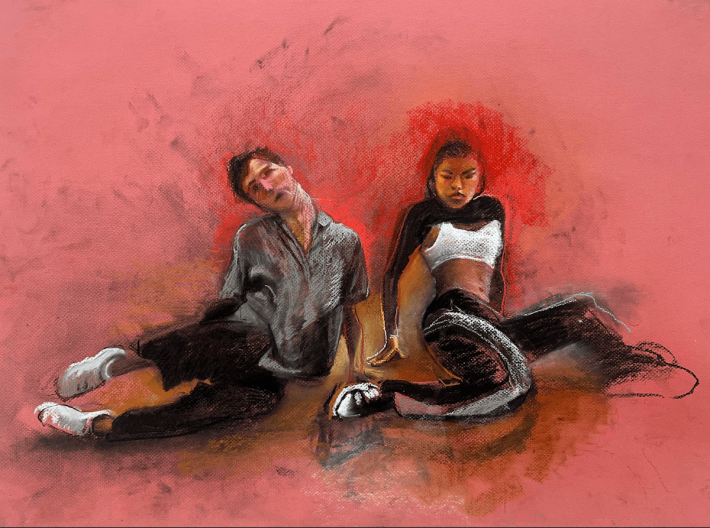
An American painter and video artist, Claudia Bitrán mines the internet for stereotypical subject matter drawn from social media and pop culture. Having created previous works based on the life and celebrity of Britney Spears, her new body of pastel and charcoal drawings on paper illustrate dancers who have worked with the pop musical icon. Combing through internet search engines for images of the dancers and doing a deep dive on their social media sites for photos of them off-stage, the Brooklyn-based artist captures an essence—part real and part imagined—of what it means to play a role in someone else’s fame while having to stay in the background. Matching the energy of the dancers’ movements with the colors she uses to quickly portray them, Bitrán gives each player a stage on which they can shine.
Image: Claudia Bitrán, Dancers 11, 2023. Pastel and charcoal on paper, 19 3/4 x 25 1/2 inches / 50.2 x 64.8 cm. Courtesy Cristin Tierney Gallery, New York
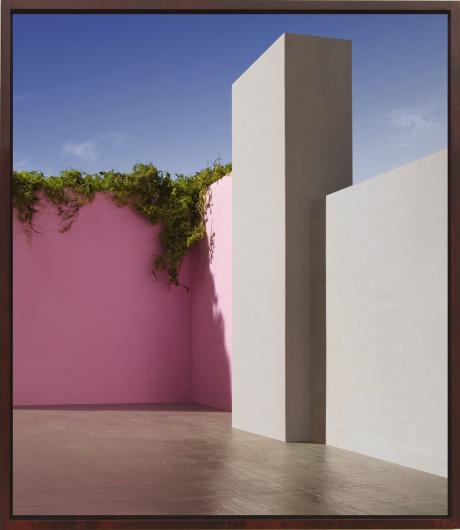
A pioneer in the realm of constructed photography, where sets are created to simulate reality and then photographed to look like they are real, James Casebere has explored all types of architecture—from traditional track houses to stylish waterfront pavilions—from the convenience of his artist studio. Creating a body of photographic works titled “Emotional Architecture” for a 2016 show at the gallery, he constructed a series of tableaux inspired by world-renowned Mexican architect Luis Barragán, without actually having physically seen any of the architect’s buildings. Revisiting the series after having visited the Pritzker Prize winner’s famous home and studio in Mexico City, he created the 2021 picture Courtyard with Foliage (Day), which depicts the rooftop space of the Luis Barragán House and Studio with such clarity that most visitors to the fair thought they were looking at a beautifully composed picture of the real thing.
Image: James Casebere, Courtyard with Foliage (Day), 2021. Framed archival pigment print mounted to Dibond paper: 53 7/8 x 46 3/4 inches (136.8 x 118.7 cm), framed: 56 11/16 x 49 9/16 x 2 1/4 inches (144 x 125.9 x 5.7 cm). © James Casebere, Courtesy the artist and Sean Kelly, New York/Los Angeles
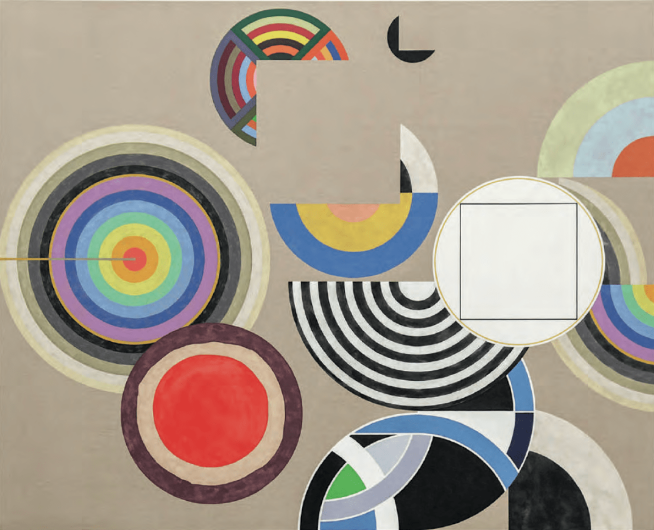
A Mexican conceptual artist, Jose Dávila employs the mediums of painting and sculpture to make art about art, which most all art basically is—even if it’s not as obvious. Appropriating and recontextualizing iconic artworks he makes us recognize and question some of the tricks of the trade. His 2023 painting, The fact of constantly returning to the same point or situation, in the gallery’s booth cleverly revisits the history of geometric abstraction through the circle and the square. Constructing a painted montage of celebrated canvases by Delaunay, Malevich, Stella, Noland and other modernist masters, Jose Dávila makes the old new again—giving visual language of the past a chance to speak with renewed volume.
Image: Jose Dávila, The fact of constantly returning to the same point or situation, 2023. Silkscreen print and vinyl paint on loom-state linen, 170 x 210 x 6 cm. Courtesy Travesía Cuatro, Madrid, Guadalajara and Mexico City
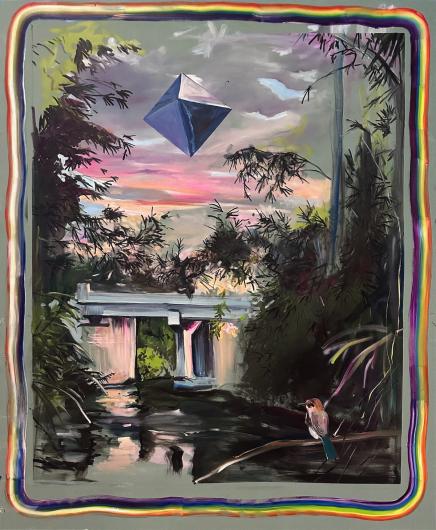
After years of making paintings, sculptures and installations about apocalyptic events that impact people’s lives, Mexican artist Marcos Castro flips the script in a series of new paintings and murals that visually convey the thoughts of a man in a burning house. In a current solo show at the gallery in Mexico City and with one painting at the fair, Castro depicts a more perfect vision of a harmonious world that the man sees as he looks out the window while chaos envelopes him. Using paint and oil stick with a mix of realism and expressionism, the artist creates a transitional realm, where in the midst of destruction the trapped man is able to see a new perspective on life—one in which the phoenix rises from the ashes and nature remakes the world in a better light.
Image: Marcos Castro, Sin título III, (Untitled III) 2023. Oil on canvas, 120 x 80 cm Courtesy MAIA Contemporary, Mexico City
Paul Laster
Paul Laster is a writer, editor, curator, advisor, artist, and lecturer. New York Desk Editor for ArtAsiaPacific, Laster is also a Contributing Editor at Raw Vision and Whitehot Magazine of Contemporary Art and a contributing writer for Art & Object, Ocula, Galerie, Artsy, Sculpture, Time Out New York, Conceptual Fine Arts, and Two Coats of Paint. Formerly the Founding Editor of Artkrush, he began The Daily Beast’s art section and was Art Editor at Russell Simmons’ OneWorld Magazine. Laster has also been the Curatorial Advisor for Intersect Art & Design and an Adjunct Curator at P.S.1 Contemporary Art Center, now MoMA PS1.























